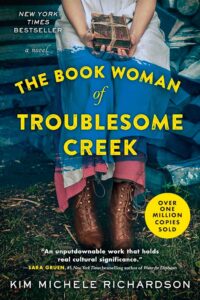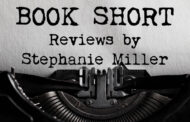Book Short
‘The Book Woman of Troublesome Creek‘
By Kim Michele Richardson
By Stephanie Miller

There really were blue-skinned people in Kentucky who carried a rare genetic condition that affected their skin color. They were treated as the lowest of the lowest social class, discriminated against to the point of abject poverty.
By the 1930’s, Cussy Mary Carter is the last of her kind along with her father, a coal-miner who, conscious of the taint of his blue skin, signs up for the worst jobs (and in a coal mine, the worst jobs are pretty deadly) because he needs to keep his place and get his share of union benefits. Together they just barely eke out a subsistence living in Troublesome Creek.
Despite the scorn and sabotage of the assistant librarian in town, Cussy gets certified to become a traveling librarian for FDR’s Kentucky Pack Horse Library Project. She rides hundreds of miles a week over rough mountain paths to bring donated books to remote homesteaders. She battles more than the elements to reach her book-thirsty clients. Prejudice runs deep, and her blue skin makes her a target for a gaggle of suspicious and bigoted townswomen and the lecherous sheriff.
Learn about the Women of the Pack Horse Library
I love learning about the courageous women of the various Pack Horse Library programs and how they changed lives through persistence, fortitude, physical strength, and a deep belief in the power of books. Richardson’s novel adds the extra layer of the blue skin and Cussy’s struggle to both accept herself and yearn for normalcy and acceptance. The result is a wonderful coming of age story set in a not-so-distant Appalachia. The love flows through this story in thick, luscious currents… nearly, but not quite, overwhelming the meanness, racism, and sadness.
As one of her clients—an intelligent 14-year-old— slowly starves to death, stories keep him from collapsing in despair. Another client’s husband tells her to stop coming as the books are distracting his family from their work. She subtly suggests cooking and farming manuals, and earns his trust to keep stopping by. The doctor won’t come to treat a cantankerous man who was wounded while attempting to steal a chicken. So she brings homespun medicines of honey and sassafras, along with fashion magazines for his devoted, pregnant, and sunny-dispositioned wife.
The stories of books bringing joy to people living in desperate conditions can easily slide into trope, but this novel keeps it real with characters who balance good sense along with scarcity. The characters are so well drawn, they stayed with me for weeks after I turned the last page.
Micro Shorts
“The Scoundrel’s Son“
By Frederic Fahey (MAINE AUTHOR)
Could an accidental and eventful friendship endure after the rightful prince returns and is crowned king in Mark Twain’s “Prince and the Pauper”? Apparently so, and Frederic Fahey of Peak’s Island has written the sequel. “The Scoundrel’s Son” is a fast-paced tale of friendship, daring adventure, royal privilege, loyalty, and first love. Fahey’s debut novel is leanly written (a contrast to Twain’s novel!) and introduces Twain’s street-smart “pauper” into the short reign of King Edward VI and the fate of his cousin, Lady Jane Grey.
“Here in the Night“
By Rebecca Turkewitz (MAINE AUTHOR)
A quote from the first of these thriller-style stories sums up the mood of Rebecca Turkewitz’s short story collection, “Here in the Night.” In “At This Late Hour,” her protagonist shares, “I’ve learned that the best way to cultivate spookiness is to only hint at it, letting the stories stand for themselves while I express my doubts.” Her characters are finely drawn and believable, which is one of the reasons we love short stories. Each of them builds in momentum, giving you that sense of urgency akin to fear, even if they don’t all end in psychological chaos. There are definitely some tales to keep you wide-awake here, but most are scary because they seem so ordinary — as if this could be happening to someone like me, right now, behind that door…
“The Diamond Eye“
By Kate Quinn
Kate Quinn is incredibly skilled at identifying and bringing attention to courageous historical heroines, including those you may recall about the women of the British and French resistance in “The Alice Network” and “Rose Code.” In “The Diamond Eye,” Quinn tells the stunning, real-life tale of Mila Pavlichenko, a Soviet sharpshooter, who ends up with an astonishing 309 official kills (and hundreds of uncounted ones).
Mila represents her marksman (markspeople?) sisters on a goodwill tour of the United States. Her delegation tries to convince FDR and the American people to join a second front and help free the Soviet Union from Hitler’s army. While she’s at it, she escapes from the devious man who impregnated her (it’s called rape now) at age 15 and, after reluctantly marrying (her father knows people), persists in emotionally abusing her ever since; falls in love (twice!) on the front lines; bewitches American society matrons and students with her fierce, foreign feminism and mastery of her skill; and even befriends Eleanor Roosevelt. Quinn once again turns a complex story into compelling, page-turning storytelling.
“True Biz“
By Sara Novic
This is an immersion class in American deaf culture disguised as a coming of age novel. The title “true biz” is an expression in American Sign Language (ASL) that means “seriously” and “real talk.” I learned a lot about the insidious bigotry against the deaf in this country and across history. The story didn’t really capture me. I found it disconnected and unconvincing with weakly drawn characters. But the history and cultural lessons made this a fascinating and sobering read. The framework of the book is terrific. Signed conversations have their own structure and there are ASL guides and political history lessons interspersed.
“Lying, Cheating & Stealing“
Edited by Sara Nickles
Everyone loves that euphoric feeling that you just got away with something. It’s one of our first instincts. Children push the boundary naturally. This collection of essays from famous writers is both fascinating, entertaining, and hilarious. Editor Sara Nickles sells us on the book in her intro:
“For those of us for whom crossing the line means taking an extra newspaper from the vending machine, this rich catalog of roguery provides illicit delights without any of the unpleasant consequences—akin to lusting in our hearts.”
(BTW, take as many copies of The West End News from the rack as you like, and share them with everyone you meet!)




